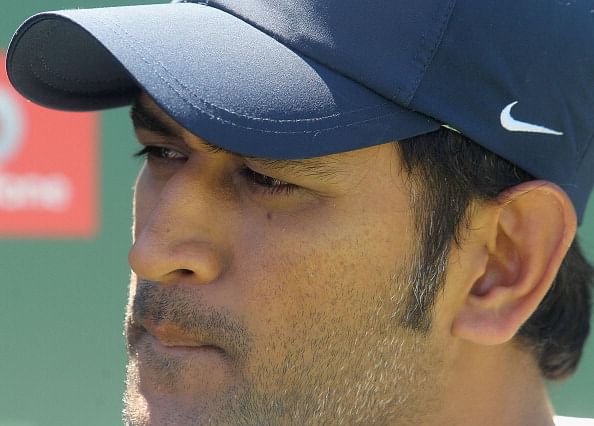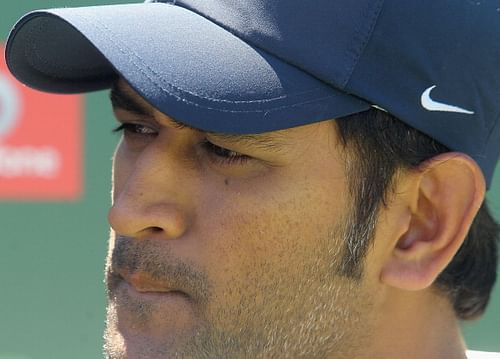
South Africa vs India 2013: The jerky discolouration of the Men in Blue

A lot to think about for MS Dhoni
Clouded by the death of South Africa’s national figure Nelson Mandela, the continuity of the Indian cricket team’s South African tour looks to be quite unsure. But despite the sadness shrouding over the nation and the ensuing overwhelming of the massiveness of India’s loss to the hosts, India’s shortcomings on the field couldn’t really be over-shadowed.
Both with the ball and the bat, team India failed. And that’s putting it lightly. Heroes cowered to become zeroes in the space of overs. The sudden abating of sixes and fours that had been flowing freely from the Indian batsmen’s bats was unnerving as was their dismal attempts to fend off the lethality of the deliveries of the South African bowlers. The transformation of the team from self-confident poise to self-doubting postures was harrowing and it was a demeanour that spoke of the bitterest truth.
For all the success that India had been enjoying, playing at home, its lack of adequate preparation and adjustment to play against South Africa was quite obvious. The matter of the prolonged haranguing and controversies between the BCCI and CSA that preceded the start of this year was raked almost again as many wondered about the rationale of scheduling a home series against West Indies, right before such an important tour.
The bottle-necked time-duration between the home series against West Indies and the South African tour impacted the Indian team’s ability to adapt to the different playing conditions. Even regarding India’s consistency this season in tests and ODIs, the fact that the team has played majority of matches at home is a marker that cannot be overlooked.
Given these aspects and considering that South Africa has been one cricketing frontier where India’s never performed exceptionally should have been reason enough to merit a tour with extended pre-match scheduling.
It also doesn’t do the Indian team any credit as it doesn’t add any reasonable justifications to their loss speaking about the freshness and inexperience of the team. Especially when the same team members were touted to be the guys to take Indian cricket to newer levels.
The 15-member team selected for the South African tour have been the choicest pick of the selection committee with their recently soaring achievements in first class and in international cricket summing up their CV for the tour. Thus, even if it were to be considered – however remotely – that inexperience was a factor that impacted the way India played in the first ODI, giving credibility to the consideration would be putting the Indian selection committee under a negative light.
The rationale would also connote that for all the ascension in rankings, both as a team and for the various individual players that India has managed to achieve this year; its ascent has been circumstantial and one that is susceptible to crumble at any possible time.
Comparing the Indian tour to South Africa to the English tour to Australia for the return leg of the Ashes makes for an interesting study. The English side reached Australia almost a month before the test series were to begin and played three practice matches so as to get acclimatised to the Australian playing conditions. This despite the fact that they were the defending champions and slight favourites going into the series thanks to their spectacular overhauling of Australia during the latter’s Ashes sojourn earlier this year.
In contrast, India’s last ODI match against the West Indies was on the 27th of November which gave the team just about nine days, including travel time, to prepare for the South African tour. It wasn’t surprising at all, under the circumstances, to see most of the Indian team wilt.
Of all the bowlers, Mohammed Shami turned out to be the most economical – even though his economy rate said a lot about the South Africans’ bludgeoning – conceding 6.8 runs and taking three wickets. The ineffectiveness of the rest of the Indian bowling attack, which went for economies not less than seven runs per over, was so clear given the way Dhoni kept using Shami at one end till the end of his 10-over spell.
Once Shami had been utilised, there was no stopping the run flow from the South Africans’ willows. AB de Villiers and JP Duminy were instrumental in wrecking apart the last lingering vestiges of respectability amongst the Indian bowlers as they reinforced the crippling problem of slog-over bowling that Indians have been unable to solve in all this while.
And where the bowlers leaked runs, the batsmen struggled to find even singles. Double centurion Rohit Sharma managed to get just 18 runs from 69 balls, slogging painfully in the middle. His opening partner, Shikhar Dhawan, though succumbed prematurely trying to find a non-existent gap.
Yuvraj Singh, Suresh Raina and even Ravindra Jadeja weren’t really able to pitch in; they never really got a chance. At the end of it all, it was Dhoni, and to a certain extent Virat Kohli, who showed some resistance. The difference by which India lost the match to South Africa, the 96-runs that these two made between themselves speaks a lot about the Indian performance at Johannesburg.
If the series does continue as scheduled, the remaining two matches will mark an irreversible pivot for India, piling the pressure on them even more than before the start of the tourney. Even if, the tour schedule does get altered because of Nelson Mandela’s funeral honours, the onus will still be on India, for they would still come out to be the team to have faltered first despite riding on the back of an extensive victory roll.